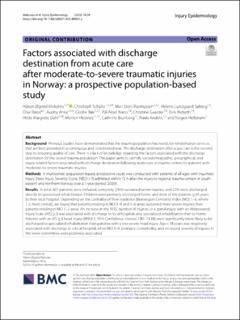| dc.contributor.author | Moksnes, Håkon Øgreid | |
| dc.contributor.author | Schäfer, Christoph | |
| dc.contributor.author | Rasmussen, Mari Storli | |
| dc.contributor.author | Søberg, Helene L. | |
| dc.contributor.author | Røise, Olav | |
| dc.contributor.author | Anke, Audny Gabriele Wagner | |
| dc.contributor.author | Røe, Cecilie | |
| dc.contributor.author | Næss, Pål Aksel | |
| dc.contributor.author | Gaarder, Aslaug Christine | |
| dc.contributor.author | Helseth, Eirik | |
| dc.contributor.author | DAHL, HILDE MARGRETE | |
| dc.contributor.author | Hestnes, Morten | |
| dc.contributor.author | Brunborg, Cathrine | |
| dc.contributor.author | Andelic, Nada | |
| dc.contributor.author | Hellstrøm, Torgeir | |
| dc.date.accessioned | 2023-07-31T09:26:59Z | |
| dc.date.available | 2023-07-31T09:26:59Z | |
| dc.date.created | 2023-06-27T09:27:06Z | |
| dc.date.issued | 2023 | |
| dc.identifier.citation | Injury Epidemiology. 2023, 10 . | en_US |
| dc.identifier.issn | 2197-1714 | |
| dc.identifier.uri | https://hdl.handle.net/11250/3081919 | |
| dc.description.abstract | Background Previous studies have demonstrated that the trauma population has needs for rehabilitation services that are best provided in a continuous and coordinated way. The discharge destination after acute care is the second step to ensuring quality of care. There is a lack of knowledge regarding the factors associated with the discharge destination for the overall trauma population. This paper aims to identify sociodemographic, geographical, and injury-related factors associated with discharge destination following acute care at trauma centers for patients with moderate-to-severe traumatic injuries.
Methods A multicenter, population-based, prospective study was conducted with patients of all ages with traumatic injury [New Injury Severity Score (NISS) > 9] admitted within 72 h after the injury to regional trauma centers in south-eastern and northern Norway over a 1-year period (2020).
Results In total, 601 patients were included; a majority (76%) sustained severe injuries, and 22% were discharged directly to specialized rehabilitation. Children were primarily discharged home, and most of the patients ≥ 65 years to their local hospital. Depending on the centrality of their residence [Norwegian Centrality Index (NCI) 1–6, where 1 is most central], we found that patients residing in NCI 3–4 and 5–6 areas sustained more severe injuries than patients residing in NCI 1–2 areas. An increase in the NISS, number of injuries, or a spinal injury with an Abbreviated Injury Scale (AIS) ≥ 3 was associated with discharge to local hospitals and specialized rehabilitation than to home.
Patients with an AIS ≥ 3 head injury (RRR 6.1, 95% Confidence interval 2.80–13.38) were significantly more likely to be discharged to specialized rehabilitation than patients with a less severe head injury. Age < 18 years was negatively associated with discharge to a local hospital, while NCI 3–4, preinjury comorbidity, and increased severity of injuries in the lower extremities were positively associated. | en_US |
| dc.language.iso | eng | en_US |
| dc.rights | Navngivelse 4.0 Internasjonal | * |
| dc.rights.uri | http://creativecommons.org/licenses/by/4.0/deed.no | * |
| dc.title | Factors associated with discharge destination from acute care after moderate-to-severe traumatic injuries in Norway: a prospective population-based study | en_US |
| dc.type | Peer reviewed | en_US |
| dc.type | Journal article | en_US |
| dc.description.version | publishedVersion | en_US |
| cristin.ispublished | true | |
| cristin.fulltext | original | |
| cristin.qualitycode | 1 | |
| dc.identifier.doi | 10.1186/s40621-023-00431-y | |
| dc.identifier.cristin | 2158306 | |
| dc.source.journal | Injury Epidemiology | en_US |
| dc.source.volume | 10 | en_US |
| dc.source.pagenumber | 0 | en_US |

